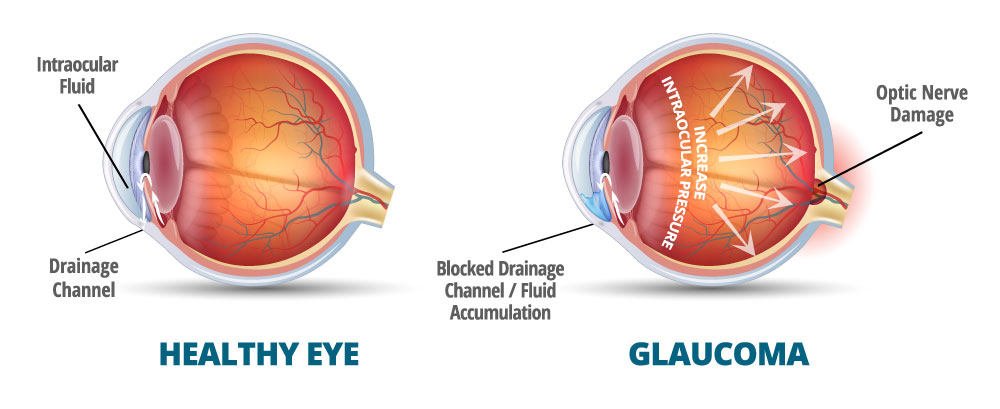Glaucoma - green star
Glaucoma, also known as a green star, is a general term of eye disease, in which the optic nerve is damaged. In the past, the eye had a greenish color in the final stages of the disease, hence the name green star. Fortunately, we hardly see the final stage in current times. The most common cause of this disease and also the best medically treatable cause is high intraocular pressure. However, glaucoma with normal or low intraocular pressure also exists.
In addition to high eye pressure, the risk factors for glaucoma include positive family history, myopia, as well as farsightedness, inflammation, tumors, eye injuries, and postoperative conditions. Among systemic diseases, it is diabetes, neurodegenerative diseases, vascular diseases, the use of certain types of drugs, e.g. steroids, antidepressants, smoking. Glaucoma is a disease that affects all ages. A congenital glaucoma also exists—babies are born with this eye disease. Another type of glaucoma is more common with increasing patient age. After the age of 40, it affects about 1% of the population, after the age of 70, it is more than 4% of the population.
Glaucoma is the second most common eye disease in the world after cataracts, which causes blindness—irreversible in this case. It can develop in the eye for several years without any symptoms, and the later the treatment is, the more complicated and less promising the treatment becomes. The best prevention is regular check-ups at the eye doctor.

Normal vision

Glaucoma Vision
Glaucoma forms
Several forms of glaucoma exist. Let's explain some of them.- Primary Open-Angle Glaucoma. This type of glaucoma is the most common, but at the beginning, it does not have any major symptoms, and the patient often notices the problem until a large part of the optic nerves have died with significant changes in the visual field.
- Primary Glaucoma With Narrow/Closed Angle. This type is more common in farsighted eyes, where the anatomical conditions in the eye are very tight. It manifests as the so-called glaucoma attack, which is associated with severe headaches, especially in the eye, due to a sudden increase in intraocular pressure. It is usually accompanied by redness of the eye, blurred vision, nausea, or vomiting, requiring immediate care by an ophthalmologist.
- Congenital Glaucoma. It is a congenital condition, in which the affected eye of a child is enlarged as the child's eye is vulnerable and enlarges due to high eye pressure. It is sensitive to light, causes excessive tearing, and the cornea becomes cloudy. The baby is crying often.
- Secondary Glaucoma. It is caused by a known identifiable cause, as we have already mentioned above, e.g. eye injury, tumors, drug use, diabetes, or vascular and other systemic diseases.
Glaucoma symptoms
Many forms of glaucoma do not initially have any specific warning signs. Patients often notice their symptoms at an advanced stage of the disease, when parts of the optic nerve are already damaged irreversibly. As glaucoma-induced vision loss cannot be restored, it is important to undergo regular eye examinations, which include, in addition to measuring eye pressure, e.g. examinations of outflow pathways, visual field testing, and optic nerve examination. If glaucoma is diagnosed at an early stage, vision loss can be significantly slowed down, and in some cases even stopped altogether.The most common symptoms of glaucoma, depending on the type and stage, are:
- Cloudy and narrowing of the view field
- Loss of spatial vision
- Glaucoma attack—sudden loss of vision
- Blurred vision
- Light sensitivity
- Headache, especially around the eyes
- Nausea
- Loss of visual acuity in an advanced stage of the disease

Glaucoma risk factors
The main risk factors include:- Heredity
- Myopia
- Inflammation, eye injury, surgery
- Smoking
- Fluctuating or very low blood pressure
- Cold limb syndrome
- General diseases—diabetes, cardiovascular diseases
- Use of some drugs, e.g. corticosteroids, antidepressants
Glaucoma treatment
Glaucoma cannot be completely cured, and its course can slow down or stabilize if it is detected and treated in an early stage. Several glaucoma treatment methods exist currently. Each treatment method aims to reduce the intraocular pressure to values that do not damage the optic nerve and to affect potential risk factors.
Glaucoma CONSERVATIVE TREATMENT
In the first step, the treatment of glaucoma is carried out by applying eye drops or drugs to reduce eye pressure.SLT-Method Laser Surgery (Selective Laser Trabeculoplasty)
When the conservative treatment fails or cannot be applied when intraocular pressure increases slightly, laser surgery may be considered. It takes place under local anesthesia, and the doctor focuses the laser beams on a specific tissue in the eye outflow tracts, improving the drainage of the intraocular fluid and reducing the eye pressure. The surgery only takes a few minutes and is almost painless. It has less frequent complications than conventional surgical treatment. More about SLT.Surgical Treatment
We recommend classic glaucoma surgery after all other options fail, either when the glaucoma is detected in a very advanced stage or young patients. The surgery most often takes place under local anesthesia and most usually it aims to create an artificial connection between the inside of the eye and the subconjunctival sac, through which the intraocular fluid can drain continuously.MUDr. Ivo Ďurkovič, MPH: ´Laser surgery and especially surgical treatment are the last treatment options for glaucoma. We recommend it only if the drug treatment is unsuccessful or the patient has difficulty using it. However, when the disease is detected at a later stage, the procedure is recommended immediately to prevent the disease from rapidly getting worse.´
Untreated glaucoma leads to blindness. Therefore, it is key to not neglect preventive medical examinations, especially in patients older than 40 years of age. Only an ophthalmologist can diagnose the problem in time and suggest proper treatment.
ARE YOU INTERESTED IN A CONSULTATION OR EXAMINATION?
Make an appointment today







